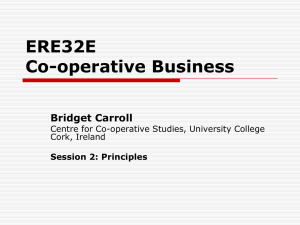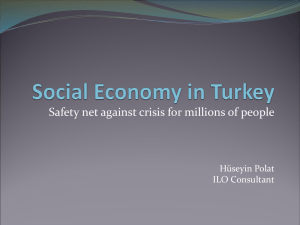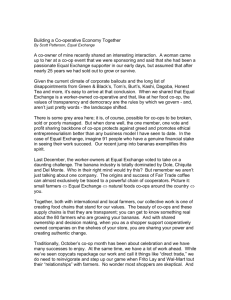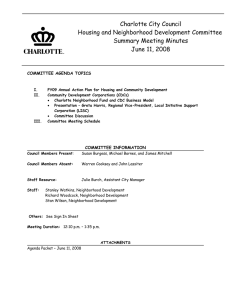What is a community land trust?
advertisement
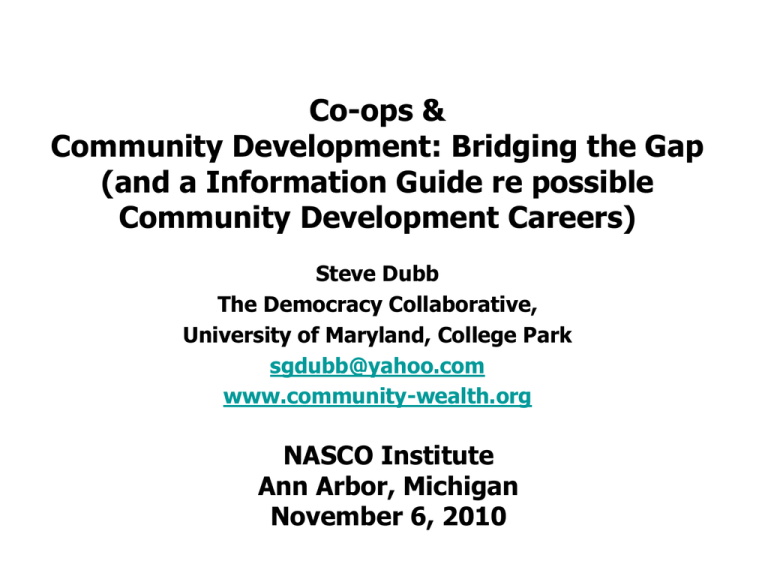
Co-ops & Community Development: Bridging the Gap (and a Information Guide re possible Community Development Careers) Steve Dubb The Democracy Collaborative, University of Maryland, College Park sgdubb@yahoo.com www.community-wealth.org NASCO Institute Ann Arbor, Michigan November 6, 2010 What is a CDC? • Community development corporations are locally based non-profits that promote investment in low and moderate income communities. (Many funding programs require that income group served be at 80% of median income or below). • Over 51% of board are community residents. • Founded as part of civil rights movement, goal is to allow low-income residents to exert economic control over their communities. • From practically no CDCs 40 years ago, there are now 4,600 today. CDCs produce over 86,000 units of affordable housing a year, as well as developing retail, commercial, and community facilities. 2 What is a CDFI? • Community development financial institutions include credit unions, loan funds, banks, and venture capital firms that finance development in low-income communities. • Many CDFIs were founded as part of civil rights movement to combat red-lining. • Mainly, but not exclusively, non-profit. • Loan volume has climbed from $2 billion in 1999 to over $20 billion today. • CDFIs have helped finance over 137,000 jobs and over 121,000 units of affordable housing since their founding. • Although not certified as such by the government, the Kagawa Fund is effectively a miniature CDFI. 3 What is a community land trust? • Non-profit in operation. Board typically consists of onethird residents, one-third non-resident community members, and one-third government officials (although some land trusts structure board differently). • Most commonly “shared equity” – residents have 99year lease but land is held by trust, with gain in value split—for instance, residents may get 25% of the equity gain while the other 75% of the gain is held by the trust (but some trusts hold 100% of equity gain, much like group-equity NASCO co-ops). • Limits on individual equity gains ensure affordability for future residents by keeping prices down, thus making the housing “permanently affordable.” • In 30 years, number of households in community land trusts has increased from 0 to over 6,000. 4 National Community Groups • • • • CDCs: The three main national groups are LISC (Local Initiatives Support Corporation), Enterprise Community Partners & NeighborWorks. These groups are known as intermediaries because they funnel dollars either from banks and private donors (LISC & Enterprise) or the federal government (NeighborWorks) to local CDCs. They also are important technical assistance & education providers. CDFIs: Opportunity Finance Network represents banks & loan funds (including Northcountry, NCB Capital Impact & Cooperative Fund of New England). Association for Enterprise Opportunity represents micro-lenders. The National Federation of Community of Community Development Credit Unions (Natfed) represents low-income community credit unions. National Community Reinvestment Coalition focuses on advocacy. Land Trusts: The newly formed National Community Land Trust Network is fueling rapid growth of this form of limited equity housing. Community Organizing: There are six large national networks:, Association of Community Organizations for Reform Now (ACORN), Center for Community Change Direct Action for Research & Training (DART), Gamaliel Foundation, Industrial Areas Foundation, and People Improving Communities through Organizing (PICO). 5 What do co-ops, CDCs, CDFIs, and land trusts have in common? • All facilitate or provide affordable housing (and many other services) to communities. • All rely on principles of community selfdetermination. • All confront a market environment that is largely unfriendly to community-driven enterprise. 6 Community Resources - Berkeley area • • • • East Bay Asian Local Development Corporation, http://www.ebaldc.org Founded in 1975, Oakland-based EBALDC serves a multi-ethnic constituency that is currently 41 percent African American, 36 percent Asian and Pacific Islander, and 11 percent Latino with the remainder being Caucasian, Native American and other ethnicities. The Unity Council, www.unitycouncil.org The Unity Council (formally called The Spanish Speaking Unity Council) has worked with the largely Latino community in the Fruitvale District of Oakland for the past four decades. Best known for Fruitvale Transit Village project. Institute for Urban and Regional Development, www.iurd.ced.berkeley.edu Since 2000, UC Berkeley’s IURD has raised more than four million dollars for collaborative projects with community based organizations (including with EBALDC and the Unity Council). Network of Bay Area Worker Cooperatives, www.nobawc.org Berkeley is part of one of the nation’s largest networks of worker-owned cooperatives, including the Cheese Board on Shattuck Avenue. 7 Community Resources - Davis region • • • Davis Food Co-op, www.davisfood.coop One of the larger food co-ops in the country with over 5,500 members, the Davis Food Co-op is also a leader in community building efforts itself, regularly making small grants to support local community groups. Sacramento Mutual Housing Association, http://www.ebaldc.org SMHA develops affordable multifamily housing through new construction on vacant in-fill lots and through acquisition and renovation of troubled properties. All residents of mutual housing participate in the operations of their properties and community building activities. (Former staff members of the organization include former NASCO staffer Eric Guetschoff). UC Davis Community Liaison Program http://psrp.ucdavis.edu/engagement_outreach/community_liaison.shtml Launched in 2006, this program emphasizes using graduate student leadership, civic engagement, and partnerships with communities to solve local environmental problems. 8 Community Resources - Santa Barbara/Ventura • Cabrillo Economic Development Corporation www.cabrilloedc.org Originally a grower-owned labor camp, today Cabrillo EDC is Ventura County’s largest affordable housing provider. • Isla Vista Food Co-op, www.davisfood.coop Serving the Isla Vista and UC Santa Barbara community for over 30 years and still recovering from a fire a couple of years ago that severely damaged the store, Isla Vista Food Co-op has often been one of the food co-ops that has maintained the closest ties to NASCO. • UCSB Community Affairs Board http://as.ucsb.edu/cab A student group founded well before “community engagement” became trendy, the program does provide a direct way to get to know and partner with local community groups. 9 Community Resources - Austin • Foundation Communities www.foundcom.org Founded in 1989, Foundation Communities operates 12 affordable housing communities ‚ 9 in Austin and 3 in the Dallas-Ft. Worth. Founding director Francie Ferguson was an early NASCO staffer. • Wheatsville Food Co-op, http://wheatsville.coop Founded in 1976 with the assistance of student housing co-ops in Austin, Wheatsville today has over 8,000 members, nearly $7 million in sales, and maintains a commitment to help other community groups as it was once helped itself. • University of Texas: Professional Development and Community Engagement Program http://www.utexas.edu/ogs/pdce Through this program University of Texas graduate students can earn academic credit for community-based work. 10 Community Resources - Ann Arbor • • • • Boggs Center www.boggscenter.org The Detroit-based Boggs Center focuses on leadership development and helping grassroots leaders develop strategies for rebuilding cities and rural communities from the ground up. LISC Detroit www.lisc.org/detroit Working with local CDCs, Detroit LISC has invested over $80 million and leveraged an additional $350 million for Detroit revitalization efforts. Midwest Association of Housing Co-ops www.mahc.coop Based in Romulus (15 miles east of Ann Arbor), the association members includes family housing co-ops from Michigan and Illinois. University of Michigan Ginsberg Center www.umich.edu/~mserve/umich_community_programs/index.html This University of Michigan-based center is home to several community programs. Undergraduate and graduate students participate in Center programs in Michigan communities and nationwide. 11 Community Resources - Lansing area • Community Economic Development Association of Michigan www.boggscenter.org Founded in 1998, CEDAM is the statewide association of community development corporations and is considered one of the leading statewide CDC associations in the country. • Midwest Interfaith Trust Fund www.interfaithtrust.org A leading statewide CDFI with offices in Lansing and Detroit, The Trust Fund underwrites projects for affordable housing, economic development, pre-development, and mixed-use development throughout the state of Michigan. • Michigan State, Center for Community and Economic Development www.cedp.msu.edu Founded in 1969 and housed off campus in Lansing, the Center supports community building efforts not only in Lansing, but in Detroit and elsewhere throughout Michigan. 12 Community Resources - Madison • • • • Common Wealth Development www.cwd.org Founded in 1980, CWD is a community development organization that develops and manages affordable housing, provides a gallery for arts, owns two business incubator sites, and runs youth programs. Credit Union National Association (CUNA) www.cuna.coop Based in Madison, CUNA is the national trade association of the U.S. credit union movement. Forward Community Investments www.madison.com/communities/danefund A Dane County-wide CDFI based in Madison, Forward Community Investments has made $3.9 million in loans to date to support 300 units of affordable housing and support two business incubators that employ 125. Willy Street Market www.willystreet.coop Willy Street Market is one of the country’s larger food co-ops with 14,500 members and over $10 million in annual sales. Willy Street also supports community groups, donating $13,000 last year. 13 Educational Resources – National • • • • COMM-ORG http://comm-org.wisc.edu One of the most comprehensive sites on community organizing out there, with listings of community organizer training programs, as well as university-based community development education programs. School of Community Economic Development, Southern New Hampshire University http://snhu.edu/sced Provides community development education for working professionals (weekend classes, held once a month). Dean Michael Swack is a former MCC staffer. Professor Christina Clamp is a member of the NCBA board. Highlander Research and Education Center www.highlandercenter.org Based near Knoxville, TN and in operation since 1932, this popular education center is best known for its work training civil rights organizers. Midwest Academy www.midwestacademy.com Provides training in direct action organizing. Despite its name, trainings are 14 held regionally throughout the United States. Leading Graduate Schools for Community Change Work • General Community Economic Development: Southern New Hampshire U.; Pratt Institute (Brooklyn); U of Illinois at Chicago, Concordia (Montreal) Building nonprofit organizations; Nonprofit management Community economic development; Housing development Community Organizing and Public Policy • Planning and Urban Studies (MIT, Cornell, UCLA) GIS (Geographic Information Systems) mapping Housing; Economic and social planning Participatory planning and participatory research Study of roles of public, private, and nonprofit sectors • Leadership Studies (Jepson School at the University of Richmond (Richmond, VA) typically “mid-career” Develop knowledge and skills as change leaders Community organizing, Participatory techniques Source: Andrew Mott, University Education for Community Change (2005) 15 Leading Graduate Schools for Community Change Work • Schools of Social Work (U. of Maryland-Baltimore, U. of Michigan-Ann Arbor) Analysis of social problems and programs Community organizing; community process skills Organizational development; study of race and diversity • Public Health (Harvard (Cambridge, MA); Vanderbilt (Nashville, TN) Public health and environment Participatory action research; community organizing and education • Public Policy (U. of Maryland-College Park, New School for Social Research (New York City), Carleton (Ottawa)) Critical analysis of democratic practice Community organizing; participatory techniques • Public Interest Law (George Washington U.-Washington, DC; Yale Law -New Haven, CT) Poverty law, Constitutional rights, Civil rights Source: Andrew Mott, University Education for Community Change (2005) 16

